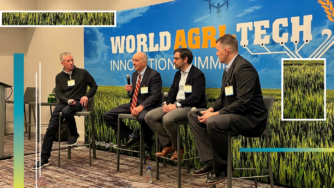How can farmers be incentivized to engage in sustainable and regenerative practices broadly? The CIBO team sat down with leaders from Anew, Land O’Lakes, and Rabobank to discuss what it takes to create meaningful and lasting engagement with growers. These leaders represent all parts of the food and ag value chain sponsoring farmer-facing sustainability programs. The webinar addressed many topics, including different types of carbon programs, incentive levels, commitment length, carbon upside sharing, agronomic support, stacking incentives, and providing transparency and optionality.
Moderator
- Dan Ryan, CIBO CEO
Panelists
- Jamie MacKinnon, SVP Carbon Programs, Anew
- Jamie Ridgely, Director of Program Development and Carbon Services, Land O’Lakes
- Ryan Findlay, Regional Lead Business Development, Carbon Banking, Rabobank
Here is an excerpt from the webinar:
We are talking about ROI and incentives to start regenerative agriculture. Farmers already shoulder an immense financial burden and risk yearly in operating expenses, capital improvements, and the costs of doing business as farmers. As new opportunities emerge for growers to participate in incentive programs, more organizations are considering this.
There are long-term financial benefits to growers transitioning, but in the initial years, the farmers are being asked to take on cost and risk, not to mention complexity and lack of clarity in some cases. What is the right mix of incentives, services and education that will drive adoption? Design the perfect program. Is there a magic number?
Jamie Ridgely from Land O’Lakes: From my personal experience and what I see, my husband from a decision-making point of view and our peers in the community as well as the retail network, a lot of it is creating the support conversation. This isn’t a decision that you make once. It’s a decision you make over again. We are working hard at Truterra to help farmers successfully transition to these practices. We know a lot of methods.
We need to integrate learning into the private sector to help make it complementary. What fit creates the tipping point on a farm-by-farm basis? It will be different in each location depending on the geography, neighborhood, etc. Service providers providing the right networks to create connectivity around trying these practices will be critical. It will be key to create a safety net from a financial and community perspective on how to work it into their system.
Ryan Findlay from Rabobank: I agree with Jamie’s comment that we need a system to understand and adopt regenerative practices. That means having the right agronomic support to help a farmer understand their specific farm. More likely, they need help with specific fields on the farms with customized practices. That will be important.
The other learning is that there is a really small number of farmers so far that have voluntarily said they want to do this. This is the right thing to do for my farm. We have noticed that some have experienced a pinch point in their farming operations that’s when they made the decision. Maybe they felt like their financials have hit a point where they need to change or it will be difficult going forward. For some of them, a supplier has pulled out. Some commodities have said they want to see certain sustainable practices so they did it for one commodity and then rolled it out across their operation.
We have not seen farmers with an income number or financial incentive. A lot of us thought we would see a response to that. It will need to be high in the current environment for a grower to respond to a financial incentive. I’m not saying it won’t happen, especially if we see things tighten over the next few years. However, that is a variable that we have. What level does it need to get to and is the premium realistic? For example, if a farmer says they need $75 per acre to implement these practices, the food and ag supply chain must pay it.
From a financial seat, we are trying to see what we can do to drive this from the economic perspective. In the last six months, I’ve heard we need finance to play here, we need finance to help drive and support farmers.
When I ask people, “What does that mean?” The first thing they say is that the interest rate has to be reduced. There should be a point or ½ point reduction. At this point, I don’t see that happening. We need to see the measure of risk; at this point it’s too volatile in regenerative agriculture. We are looking into it, but that is right now, something we don’t see the opportunity to do yet. Certainly, as it relates to loans in regard to certain equipment, that is definitely on the table. If we look at individual products, from the grower to agronomic advisor, processor, food company, is there some financial product that can be turned into a program. It’s not systematic; it’s not something we see across the board but project by project.
The short answer is that there isn’t a single financial product we can hold up today and say “this is the answer.” Like everything else we’re talking about, it will happen in iterations. It’s something we think will be important going forward and as a lender, we’re engaging with a number of groups to have those conversations about what it could look like.
Jamie MacKinnon from Anew: Practice adoption will be incremental, it’s vital for the sustainability of these programs to build on a suite of regenerative practices and not just rely on one. This reduces the risk that we lose the carbon sequestered. Not enough attention is being paid to. Building a suite of practices that are resilient to changes is important. You can do that by starting with a simple matter. One thing we’re looking at is crediting the use of nitrogen inhibitors. The value from a carbon perspective is not particularly compelling on a per-acre basis but it’s the material cost of reducing the nitrogen inhibitor and there are no long-term requirements. The data is simple. The tradeoff between the data burden, commitment time, and value to the grower is very interesting, although it is a different proposition value than a traditional program.
The last thing I’ll mention is that I was at a Wisconsin meeting earlier this year. There was a lot of talk around dairy farmers around their participation in the regenerative programs to fend off either regulatory or requirements they imposed down in the food chain. They were apprehensive about that. It was a motivating factor for them to participate in programs that incentivized them instead of requiring them to take action.



